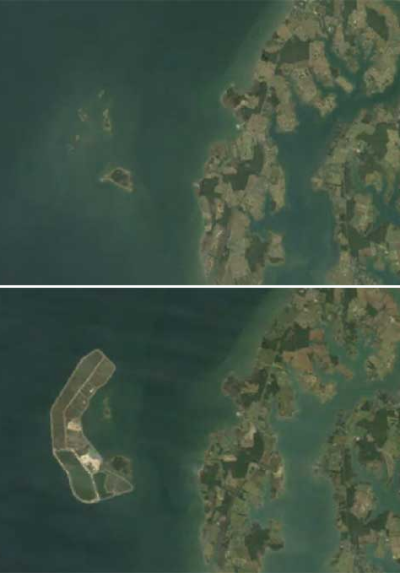
Satellite photo of Poplar Island in 1998 (top) vs. 2012 (bottom).
WASHINGTON—A Chesapeake Bay island, once used as a presidential retreat but diminished to fewer than 5 acres by the 1980s, has been replenished with dredged material, creating wetlands that serve as a wildlife sanctuary.
Poplar Island, located one mile northwest of Tilghman Island in Talbot County, began to vanish, like many bay islands, due to rising sea levels and erosion.
The restoration project, a joint effort of the U.S. Army Corps of Engineers and the Maryland Port Administration, received additional funding in President Barack Obama’s budget for fiscal year 2016. The appropriations would be used to expand the island by 575 acres over the previous goal of 1,100 acres, an expansion approved by the president and Congress last year.
The initial project is nearly complete and will not be able to hold any more dredged material. The expansion will allow the island to continue to provide beneficial habitat construction, according to the Maryland Port Administration.
The budget’s $26.5 million allocation for the Poplar Island project represents a 75 percent increase over the previous year’s proposal. The federal government funds three quarters of the project and the state is responsible for the remainder.
See Also: Poplar Island's budget expected to grow this yearThe island has been rebuilt with material dredged from the Maryland Bay Channels and the approach channels to the Chesapeake and Delaware Canal, a total of about 3.2 million cubic yards per year, said Justin Callahan, the Poplar Island project manager for the Corps of Engineers.
“Poplar is groundbreaking because it takes dredged material and is using it beneficially,” said David Blazer, director of the Harbor Development Department of the Maryland Port Administration.
This type of project hasn’t been done to this scale before and it is generating interest worldwide, he added.
See Also: Poplar Island regrows in the BayDelegations from other nations, including Germany and Brazil, have toured the island.
Poplar’s 3.2 million cubic yards of dredged material is about 60 percent of the approximately 5.2 million cubic yards dredged in Maryland shipping channels every year.
The bay has a natural tendency to refill its deep spots through a variety of factors, including natural erosion and tidal waters, Blazer said.
The dredged material used for Poplar Island is all considered clean. Contaminated material is sent to state containment facilities.According to the EPA, sediment around cities and industrial areas is often polluted from runoff and industrial waste.
Dredging is necessary to keep channels deep enough to allow ships to reach the Port of Baltimore and the Chesapeake and Delaware Canal.
With a 50-foot deep approach channel, Maryland is equipped for the larger ships expected to come through an expanded Panama Canal. The Port Administration and Corps of Engineers are investigating widening the channels for wider vessels, Blazer said.
After material is dredged by scows, it is sent to Poplar Island where the slurry, a mixture of the sediment and water, is remixed in uploaders and then pumped into containment cells designed to hold the dredged substance, Callahan said.
The extra money for Poplar Island in this year’s proposed budget would account for the expansion of the island. Recently, the budget for Poplar Island, including the state portion, has been between $13 and $15 million a year, Blazer said.
The total cost of the expansion is expected to be between $140 and $150 million.
Construction to restore the island to 1,100 acres began in 1998 and with the expansion the project is approximately expected to finish around 2043.
In the mid-1800s, Poplar Island encompassed over 1,100 acres and included fields, forests and marshland. During the 1940s, Franklin Roosevelt and Harry Truman used the island as a presidential retreat.
Islands like Poplar have also been natural habitats for herons and diamondback terrapins.
Dredged material has been used to recreate landmasses and habitats before, such as Hart and Miller Island at the mouth of the Patapsco River. Poplar is groundbreaking because it creates large scale wetlands in addition to uplands, according to Blazer.


